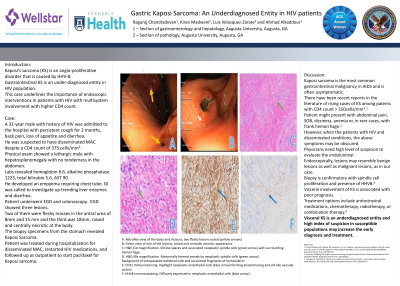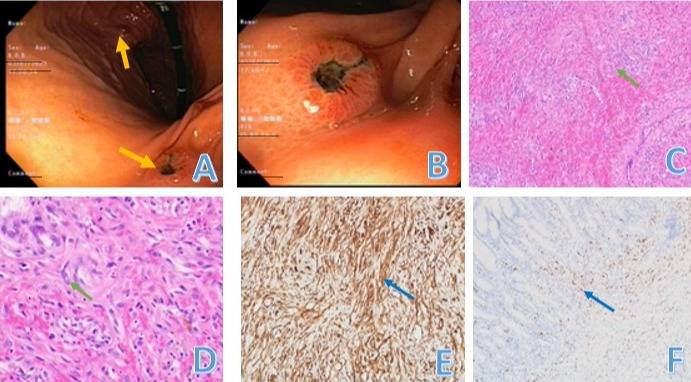Sunday Poster Session
Category: Stomach
P1402 - Gastric Kaposi Sarcoma: An Underdiagnosed Entity in HIV Patients
Sunday, October 22, 2023
3:30 PM - 7:00 PM PT
Location: Exhibit Hall


Raguraj Chandradevan, MD
Medical College of Georgia at Augusta University
Augusta, GA
Presenting Author(s)
Award: Presidential Poster Award
Raguraj Chandradevan, MD, Kiran Madwani, MD, Luis Velasquez-Zarate, MD, Ahmad Alkaddour, MD
Augusta University Medical Center, Augusta, GA
Introduction: Kaposi’s sarcoma (KS) is an angio-proliferative disorder that is caused by HHV-8. Gastrointestinal KS is an under-diagnosed entity in HIV population. This case underlines the importance of endoscopic interventions in patients with HIV with multisystem involvement with higher CD4 count.
Case Description/Methods: A 31-year male with history of HIV was admitted to the hospital with persistent cough for 2 months, back pain, loss of appetite and diarrhea. He was suspected to have disseminated MAC despite a CD4 count of 375 cells/mm3. Physical exam showed a lethargic male with hepatosplenomegaly with no tenderness in the abdomen. Labs revealed hemoglobin 8.6, alkaline phosphatase 1223, total bilirubin 5.6, AST 90. He developed an empyema requiring chest tube. GI was called to investigate up trending liver enzymes and diarrhea. Patient underwent EGD and colonoscopy. EGD showed three lesions. Two of them were fleshy masses in the antral area of 8mm and 15mm and the third was 18mm, raised and centrally necrotic at the body. The biopsy specimens from the stomach revealed Kaposi Sarcoma. Patient was treated during hospitalization for disseminated MAC, restarted HIV medications, and followed up as outpatient to start paclitaxel for Kaposi sarcoma.
Discussion: Kaposi's sarcoma is the most common gastrointestinal malignancy in AIDS and is often asymptomatic. There have been recent reports in the literature of rising cases of KS among patients with CD4 count > 350 cells/mm3. Patient might present with abdominal pain, SOB, dizziness, anemia or, in rare cases, with frank hemorrhage. However, when the patients with HIV and disseminated conditions, the above symptoms may be obscured. Physicians need high level of suspicion to evaluate the endoluminal. Endoscopically, lesions may resemble benign lesions as well as malignant lesions, as in our case. Biopsy is confirmatory with spindle cell proliferation and presence of HHV 8. Visceral involvement of KS is associated with poor prognosis. Treatment options include antiretroviral medications, chemotherapy, radiotherapy, or combination therapy. Visceral KS is an underdiagnosed entity and high index of suspicion in susceptible populations may increase the early diagnosis and treatment.

Disclosures:
Raguraj Chandradevan, MD, Kiran Madwani, MD, Luis Velasquez-Zarate, MD, Ahmad Alkaddour, MD. P1402 - Gastric Kaposi Sarcoma: An Underdiagnosed Entity in HIV Patients, ACG 2023 Annual Scientific Meeting Abstracts. Vancouver, BC, Canada: American College of Gastroenterology.
Raguraj Chandradevan, MD, Kiran Madwani, MD, Luis Velasquez-Zarate, MD, Ahmad Alkaddour, MD
Augusta University Medical Center, Augusta, GA
Introduction: Kaposi’s sarcoma (KS) is an angio-proliferative disorder that is caused by HHV-8. Gastrointestinal KS is an under-diagnosed entity in HIV population. This case underlines the importance of endoscopic interventions in patients with HIV with multisystem involvement with higher CD4 count.
Case Description/Methods: A 31-year male with history of HIV was admitted to the hospital with persistent cough for 2 months, back pain, loss of appetite and diarrhea. He was suspected to have disseminated MAC despite a CD4 count of 375 cells/mm3. Physical exam showed a lethargic male with hepatosplenomegaly with no tenderness in the abdomen. Labs revealed hemoglobin 8.6, alkaline phosphatase 1223, total bilirubin 5.6, AST 90. He developed an empyema requiring chest tube. GI was called to investigate up trending liver enzymes and diarrhea. Patient underwent EGD and colonoscopy. EGD showed three lesions. Two of them were fleshy masses in the antral area of 8mm and 15mm and the third was 18mm, raised and centrally necrotic at the body. The biopsy specimens from the stomach revealed Kaposi Sarcoma. Patient was treated during hospitalization for disseminated MAC, restarted HIV medications, and followed up as outpatient to start paclitaxel for Kaposi sarcoma.
Discussion: Kaposi's sarcoma is the most common gastrointestinal malignancy in AIDS and is often asymptomatic. There have been recent reports in the literature of rising cases of KS among patients with CD4 count > 350 cells/mm3. Patient might present with abdominal pain, SOB, dizziness, anemia or, in rare cases, with frank hemorrhage. However, when the patients with HIV and disseminated conditions, the above symptoms may be obscured. Physicians need high level of suspicion to evaluate the endoluminal. Endoscopically, lesions may resemble benign lesions as well as malignant lesions, as in our case. Biopsy is confirmatory with spindle cell proliferation and presence of HHV 8. Visceral involvement of KS is associated with poor prognosis. Treatment options include antiretroviral medications, chemotherapy, radiotherapy, or combination therapy. Visceral KS is an underdiagnosed entity and high index of suspicion in susceptible populations may increase the early diagnosis and treatment.

Figure: A: Retroflex view of the body and incisura, two fleshy lesions noted (yellow arrows)
B: Direct view of one of the lesions, raised and centrally necrotic appearance
C: H&E,10x magnification. Slit like spaces and associated neoplastic spindle cells (green arrow) with surrounding hemorrhage.
D: H&E,40x magnification. Abnormally formed vessels by neoplastic spindle cells (green arrow). Background of extravasated red blood cells and occasional fragments of hemosiderin.
E: CD31 immunostaining. Highlight neoplastic endothelial cells (blue arrow) forming anastomosing and slit-like vascular spaces.
F: HHV8 immunostaining. Diffusely expressed in neoplastic endothelial cells (blue arrow).
B: Direct view of one of the lesions, raised and centrally necrotic appearance
C: H&E,10x magnification. Slit like spaces and associated neoplastic spindle cells (green arrow) with surrounding hemorrhage.
D: H&E,40x magnification. Abnormally formed vessels by neoplastic spindle cells (green arrow). Background of extravasated red blood cells and occasional fragments of hemosiderin.
E: CD31 immunostaining. Highlight neoplastic endothelial cells (blue arrow) forming anastomosing and slit-like vascular spaces.
F: HHV8 immunostaining. Diffusely expressed in neoplastic endothelial cells (blue arrow).
Disclosures:
Raguraj Chandradevan indicated no relevant financial relationships.
Kiran Madwani indicated no relevant financial relationships.
Luis Velasquez-Zarate indicated no relevant financial relationships.
Ahmad Alkaddour indicated no relevant financial relationships.
Raguraj Chandradevan, MD, Kiran Madwani, MD, Luis Velasquez-Zarate, MD, Ahmad Alkaddour, MD. P1402 - Gastric Kaposi Sarcoma: An Underdiagnosed Entity in HIV Patients, ACG 2023 Annual Scientific Meeting Abstracts. Vancouver, BC, Canada: American College of Gastroenterology.

